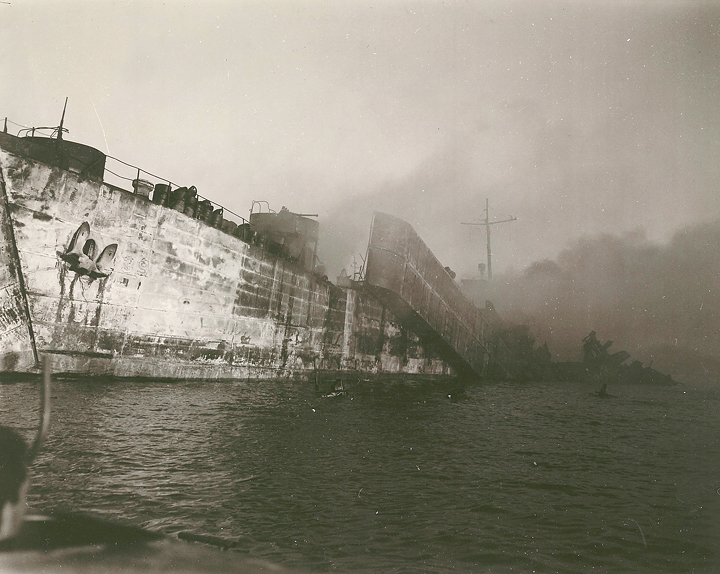It was another sunny Hawaiian day interrupted by loud explosions and burning ships.
Three years after the Japanese attack on Pearl Harbor, a different type of explosion rocked the South Shore of Oahu in the West Loch Disaster of May 21, 1944.
Wilmington resident Leo Bednarczyk, now 89, was a 19-year-old engineer aboard one of the amphibious Landing Ship, Tanks (LSTs) docked in West Loch and can still remember the sights and sounds from that day.
During World War II, West Loch served as the ammunitions and oil storage area for the entire Naval Station Pearl Harbor, and May 21 was loading day as the fleet readied for the invasion of the Northern Marianas Islands.
“If the Japanese bombed that during the Pearl Harbor attack they would have put us out of commission, that is how important [West Loch] was,” Bednarczyk said.
One of the roughly 40 ships anchored in West Loch was being loaded with mortar shells and around 2:30 p.m. a booming explosion sent the sailors in West Loch into high alert, ready for another attack.
“It being a Sunday all of the guys, including most of my crew, were on liberty in Honolulu so we just had a skeleton crew when we heard this big explosion,” Bednarczyk recalled. “While my ship was not involved directly with that, I was maybe 300 feet away so shrapnel was flying all over the place. We thought it was another attack like it was on December 7, 1941.”
Immediately Bednarczyk was ordered to make his ship ready.
“We hear the explosion and then over the public address system the captain said, ‘Bednarczyk, get down to the engine room and start the engines,’” he said. “I heard all kinds of explosions and things hitting the ship and when I went up to get some fresh air an hour later I saw all these ships afire.”
The fire from the initial explosion had spread to the nearby LSTs and in the next 24 hours six LSTs sank, 163 sailors and naval personnel died and 396 were injured.
Those 24 hours after the explosion passed like a blur to Bednarczyk, who was part of a crew that patrolled West Loch for survivors.
“Then the next thing we knew we were manning the two smaller boats to help with survivors but … I guess the excitement was such that I don’t remember much of that,” he said.
Seventy years later, Bednarczyk still calls the task of collecting survivors the worst feeling of his life.
“We were involved in picking up survivors or what was left of them over the next week with a boat hook,” Bednarczyk said. “We were in sad situations during the invasion [of the Marianas] but this thing made us sick. It was probably one of the worst things I’ve ever had to do.”
However, Bednarczyk said there would have been many more casualties if the explosion happened on any day other than Sunday. In another happy turn, one of his former shipmates on the LST nearest the explosion was found alive and well two days later.
“We saw him on a beach two days later in casual attire,” Bednarczyk said, laughing. “He had been blown from the ship and to safety.”
The following Friday, Bednarczyk and the rest of the fleet assigned set out for Operation Forager and the invasion of the Japanese-held Marianas Islands. The successful capture of Saipan and Tinian would provide the take off location for the B52 aircrafts that dropped atomic bombs on Hiroshima and Nagasaki.
However, it would be a long time before the U.S. Navy let out any information about the West Loch Disaster for fear of alerting enemies to the whereabouts of ammunitions and oil storage locations.
“It was kept under wraps by the Navy for nearly 20 years and every one of us were upset when we found out about it,” Bednarczyk said. “According to the Navy inquiry no one ever knew what caused it … but there were reports of a captain complaining of unsafe loading practices going on before it happened.”
Sixty years after the disaster, Bednarczyk stumbled upon a 60th anniversary ceremony being held at West Loch for all its survivors. Already committed to a WWII reunion with his old shipmates in Arizona, Bednarczyk was unable to attend but received a package from the Navy shortly afterward.
“About three weeks later I got a package … and it contained all of the newspapers that covered it at the time and a disk with photographs that the Navy took,” he said. “I sat on the floor opening this box and when I saw what it was I started to cry. My wife asked me what I got and I said, ‘Something I never thought I would get from the Navy.’”
Ten years later, Bednarczyk still thinks the West Loch Disaster is a relatively untold story of WWII.
email [email protected]




